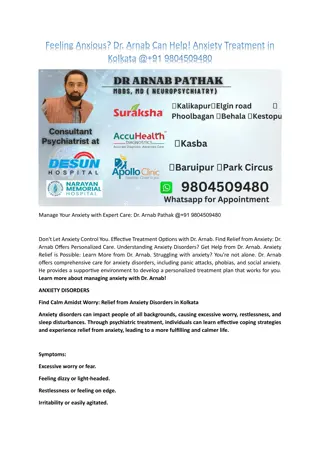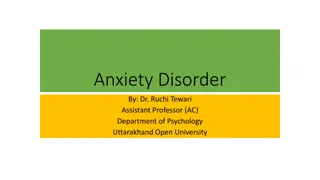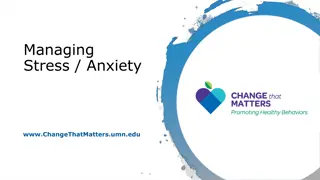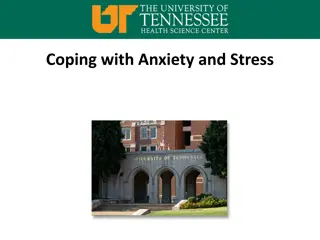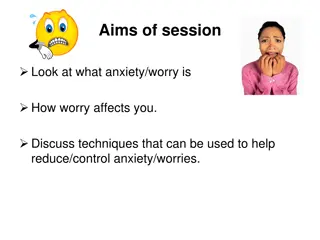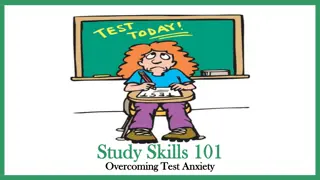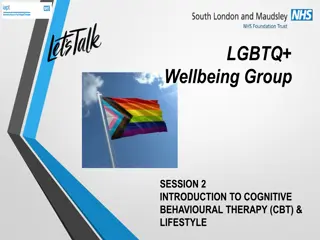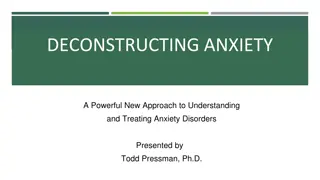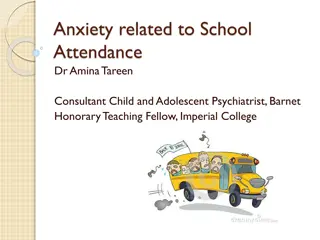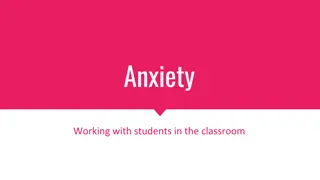Understanding Stress and Anxiety in Sports
Stress and anxiety play significant roles in sports performance. Stress can be positive (eustress) or negative (distress), affecting athletes differently. Common stressors in sports include playing through injury, competing in hostile environments, facing local rivals, and high-pressure match situations. Understanding the effects of stress and anxiety is crucial for athletes and coaches to optimize performance and well-being.
Download Presentation

Please find below an Image/Link to download the presentation.
The content on the website is provided AS IS for your information and personal use only. It may not be sold, licensed, or shared on other websites without obtaining consent from the author. Download presentation by click this link. If you encounter any issues during the download, it is possible that the publisher has removed the file from their server.
E N D
Presentation Transcript
Level 3 Cambridge Technical Extended Certificate Level 3 Cambridge Technical Extended Certificate in Sport and Physical Activity in Sport and Physical Activity Unit 19: Sport and Exercise Psychology Unit 19: Sport and Exercise Psychology Allerton Grange P.E. Department Allerton Grange P.E. Department
Learning Outcome 3: Understand the effects of stress, anxiety and arousal in sport and exercise. Title: Stress and Anxiety in Sport Date: 14/10/2019
Stress Stress can be defined as an individual s physical response to prepare the body for action when a threat is perceived. There are two types of stress: EUSTRESS EUSTRESS Eustress is used to describe positive responses to stressful situations and is when the performer rises to the challenge they are facing. Performance is improved. DISTRESS DISTRESS Distress is used to describe negative responses to stressful situations, where the performer feels threatened and struggles to cope. Performance is negatively effected.
Causes of Stress The causes of stress are called STRESSORS. Stress can be very personal and range from person to person but common stressors in sport could be
Playing through an injury or returning to play again after an injury. For example, a Premier League footballer in his first match back after breaking his leg may be stressed about going into a tackle.
Playing in a hostile environment or in front of a hostile crowd. For example, England s black players may be slightly stressed about playing in Bulgaria where their fans have been in trouble for racist behaviour.
Playing in a big match against local rivals or against high quality opposition. For example, Manchester United players may be stressed before playing against Manchester City as they are their local rivals.
High-pressured match situations. For example, international footballers may be stressed before they have to take a penalty in a penalty shoot-out in the World Cup.
Significance of the result. For example, Premier League footballers may be stressed going into a game that they must win in order to avoid relegation or a professional cricket player may be stressed before playing in the World Cup final.
Fear of failure or knowing you are being watched by significant others such as a peer or coach. For example, English players in the Premier League may be stressed if they know that the England manager is coming to watch their game.
Effect of Stress on Sport and Exercise Performance Stage One: Demand For example, taking the last penalty in a penalty shoot-out. Stage Two: Athlete s Perception Positive Negative FIGHT OR FLIGHT RESPONSE Stage Three: Stress Distress Eustress Stage Four: Impact on Performance Negative Impact on Performance Positive Impact on Performance
Symptoms of Stress Somatic - Increased adrenaline production Cognitive - Worry or anxiety - Negative thoughts - Increased heart rate - Issues with focus - Increased sweat production - Lack of confidence - Increased muscle tension
Effect of Stress on Performance in Sport and Exercise Eustress Eustress Distress Distress - Increased excitement and enjoyment. - Leads to severe worry and anxiety. - Increased motivation. - Feelings of unpleasantness. - Increased energy levels. - Decreases focus and concentration. - Increased heart rate so that more oxygen is going to working muscles. - Lack of confidence. - Muscle tension. - Increased focus. - Poor execution of skills. Andy Murray Bundesliga Footballer
Stress can have both positive and negative impacts on performance, depending on whether a performer experiences eustress or distress. Eustress is where a performer rises to the challenge of the stressful situation and consequently experiences an improvement in performance. Eustress can lead the performer to feel excited, more energised and more motivated whilst one of the symptoms of stress, an increased heart rate, means that more blood is flowing to working muscles which can benefit performance. For example, a cricket player who needs to score twenty runs off the last over to win the match is placed in a stressful situation but because of these positive effects, may rise to the challenge and score the runs needed. When performers experience distress, stress can be seen to have a negative impact on performance. Symptoms such as worry or a lack of confidence could manifest itself in a lack of focus and unpleasant feeling, whilst muscle tension and sweating could lead to poor execution of skills. For example, a tennis player who is serving to stay in a match may experience distress, his muscles may tighten and the execution of his serve could suffer, leading to him losing points by serving the ball out. Distress is also common in exercise settings, where worry and a lack of confidence can be experienced by participants who may feel anxious about their level of fitness or weight. For example, a general participant may experience distress and a lack of confidence before going to the gym due to their body image which could lead them to avoiding exercise altogether.
Symptoms of Stress Symptoms of stress can be grouped into two categories: SOMATIC SOMATIC Symptoms that have a physical effect on the body. COGNITIVE COGNITIVE Symptoms that have a mental effect.
Anxiety Anxiety is the negative consequence of experiencing stress and is the worry or apprehension experienced because of the fear of failure. STATE: STATE: State anxiety is where you are only anxious in certain situations. TRAIT: TRAIT: Trait anxiety is where you are genetically anxious in all situations. The causes of anxiety are much the same as those that cause stress.
Trait and State Anxiety in Sport Competitive trait anxiety is where a performer has a natural tendency to become anxious in all sporting situations. E.G. A skier being anxious before going down a ski slope, regardless of how difficult it is. Competitive state anxiety is where a performer is only anxious in specific sporting situations, for example when under lots of pressure. E.G. A defender in football being anxious when taking a penalty because he missed the last penalty he took.
Symptoms of Anxiety Somatic - Increased adrenaline production Cognitive - Indecision or concentration loss - Confusion - Increased heart rate - Negative thoughts - Increased sweat production - Poor concentration - Increased muscle tension - Loss of confidence
Effect of Anxiety on Performance in Sport and Exercise Symptom of Anxiety Effect on Performance 1. Increased production of adrenaline, increased heart rate and increased sweat production. ADD A SPECIFIC SPORTING EXAMPLE FOR EACH. Physiologically should have a positive effect on performance but if the athlete is feeling anxious, then they would only make the athlete feel even worse as it adds to the feeling of panic or worry. Can lead to issues with movement and the execution of skills through the body freezing or feeling tense. 2. Increased muscle tension. Leads to mistakes or inaccuracies in performance, especially in sports that require high levels of concentration or focus such as golf or snooker. 3. Loss of concentration or focus. This can lead to making incorrect choices which can negatively impact on performance by leading to mistakes. 4. Indecision. Makes the athlete more likely to think that failure is inevitable which only increases the chance of failure. 5. Loss of confidence.
Choking in Sport In sport, choking refers to a serious failure in performance and is often used when a team or performer fails from a position where it seems impossible to not win. It is caused by anxiety. Jordan Spieth at the Masters https://www.youtube.com/watch?v=PPLsVVEWXhY Dustin Johnson at the US Open https://www.youtube.com/watch?v=3MGb9iDBPBw Blair Walsh in the NFC Championship game https://www.youtube.com/watch?v=Mb_eXyhlHaA
Learning Outcome 3: Understand the effects of stress, anxiety and arousal in sport and exercise. Title: Arousal in Sport Date: 17/10/2019
Arousal Arousal is a physiological and psychological Arousal is a physiological and psychological state of motivation, alertness and readiness. state of motivation, alertness and readiness. Performance may be worse if athletes are under- aroused or over-aroused. All athletes are seeking for an optimum arousal, where performance is at its best. optimum level of
Effects of Arousal Increased levels of arousal Increased levels of arousal can lead to can lead to If a performer becomes too If a performer becomes too aroused they may aroused they may - Increased focus and concentration. - Develop anxiety or apprehension. - Increased awareness. - Become tense. - Narrowing of attention which means that irrelevant stimuli are excluded. - Struggle to concentrate - Develop fear or anger during performance. - Quicker reaction time.
Arousal When discussing the effect of arousal on performance in sport, there are a number of theories to discuss: - Drive Theory - Inverted U Theory - Catastrophe Theory - Individual Zone of Optimal Functioning Theory - Reversal Theory
USING THE GRAPHS TO HELP YOU CAN YOU ANNOTATE USING THE GRAPHS TO HELP YOU CAN YOU ANNOTATE SOME IDEAS AROUND THE GRAPHS TO HELP US THINK SOME IDEAS AROUND THE GRAPHS TO HELP US THINK ABOUT THE FIVE THEORIES OF AROUSAL ABOUT THE FIVE THEORIES OF AROUSAL - What do you think the theory suggests about how arousal effects performance? - How does the theory suggest arousal affects performance positively? - How does the theory suggest arousal affects performance negatively? - Can you make up a sporting example that uses the theory to describe a situation where a performer is playing well or badly? - Can you identify any reasons why the theory is not a very good one?
Drive Theory - Drive theory argues that the relationship between arousal and performance is linear. This means that arousal This means that arousal increases, performance also increases. increases, performance also increases. - The theory argues that as arousal increases, experienced performers are more likely to revert to their dominant responses responses such as movements or skills they are good at which is likely to result in an improved performance. dominant - The theory is now considered to give a poor explanation of the relationship between arousal and performance. This is because when we observe even the best athletes, there is a point where they become too aroused and performance does not improve or gets worse. It also fails to take into account differences between arousal levels in performers of different sports or at different experience levels, for example elite and beginner athletes.
Inverted U Theory - Similarly to Drive Theory, the Inverted U theory also suggests that initially, as a performer becomes more aroused, their performance level increases. - However, Inverted U theory does take into account the idea of an optimum level of arousal , where performance is at its best. - Inverted U theory then suggests if a performer goes beyond their optimum level of arousal and becomes over-aroused then performance will start to slowly decrease in quality. - It is widely viewed as more realistic than Drive Theory but again fails to recognise the differences in arousal levels between beginner and elite athletes or by athletes playing different sports. For example, research suggests rugby players need higher levels or arousal to perform at their best compared to a golfer who will play better at lower levels of arousal.
Catastrophe Theory - This theory is a development of Inverted U theory and begins to explain why sometimes, performers can experience a rapid decline in their quality of performance. It helps to explain why athletes may choke or make a horrendous mistake a catastrophe. - Like the first two theories, catastrophe theory argues that as arousal increases, performance level increases up to an optimum level of arousal, where an athlete is playing their best. - However, once an athlete becomes too over-aroused, they experience a sudden and large decline in the quality of their performance, caused by their high level of arousal leading to high somatic and cognitive anxiety. - It then argues further that the athlete may then attempt to drop their arousal levels using relaxation techniques in an attempt to try and recover their performance which may or may not be successful. Zinedine Zidane in the World Cup Final https://www.youtube.com/watch?v=zAjWi663kXc
Individual Zone of Optimal Functioning Theory - Individual zone of optimal functioning theory is a theory that firstly begins to argue that different athletes work better at personal, individualised levels of arousal depending on their personality or their sport. For example, a golfer may perform better at lower levels of arousal, a footballer might play better at moderate levels of arousal where a rugby player may need to be highly aroused in order to play well. - It argues against the idea of an optimum level of arousal, instead arguing that optimum performance is achieved when a performer is in a particular zone . - The zone is a widely discussed idea in sport where a performer is playing at their absolute best. Here, an athlete may achieve the feeling that they are feeling in complete control, feeling confident and performing smoothly, efficiently and effortlessly.
Reversal Theory - Reversal theory aims to discuss how performers arousal and psychological state can fluctuate from moment to moment, depending on them and the meaning they attach to a given situation at a given time. For example, a performer sometimes may be inspired by the crowd to perform better and in other situations, the pressure from the crowd may make them feel anxious. - It suggests that performers can fluctuate from relaxed to anxious and from bored to excited at various times throughout their performance. For example, a footballer may be excited at the start of a game but become more bored if they are not seeing any of the ball or if their team are winning by a lot of goals. - It suggests that performance is best when performers are not at either of the two extreme ends of the two spectrums and that performance is therefore at its best when athletes are in an optimum work zone where they are not too relaxed or anxious and not too excited or bored.
Do Now: Sporting Examples In your assignment - INTRODUCE A THEORY - EXPLAIN WHAT THIS THEORY SAYS ABOUT HOW AROUSAL EFFECTS PERFORMANCE. - Drive Theory - MAKE UP A SPORTING EXAMPLE THAT USES THIS THEORY - Inverted U Theory - HAVE A GO NOW AT FIVE SPORTING EXAMPLES - Catastrophe Theory For example Catastrophe theory could be used to explain the performance of Loris Karius in the Champions League final. He became too over- aroused due to the pressure of the game which may have led to feelings of anxiety. This meant that he made two catastrophic mistakes that ended up costing his team the game . - Individual Zone of Optimal Functioning Theory - Reversal Theory
Learning Outcome 3: Understand the effects of stress, anxiety and arousal in sport and exercise. Title: Methods of Controlling Stress, Anxiety and Arousal Date: 11/11/2019
Why? The best athletes are able to control their stress, anxiety and arousal to maintain optimum performance by psyching themselves up or by relaxing themselves if they are too stressed, anxious or aroused.
Somatic or Cognitive? Somatic or Cognitive? Just like with the symptoms of stress and anxiety, the methods of controlling stress, anxiety and arousal can be grouped into the following categories: SOMATIC Methods that aim to control stress, anxiety and arousal by physically effecting the body in some way. COGNITIVE Methods that aim to control stress, anxiety and arousal through altering the performer s mental state.
Somatic or Cognitive? Somatic or Cognitive? Somatic Control Cognitive Control Self-Talk Biofeedback Positive Thinking Imagery Visualisation Cue Utilisation Thought-Stopping Breathing Control Progressive Muscular Relaxation Attentional Control Concentration
Method Used Successful Baskets None Imagery Mental Rehearsal/Visualisation Positive Self-Talk
Imagery and Visualisation https://www.youtube.com/watch?v=VHISQ6xIGZE Imagery and visualisation are going to be discussed as two separate methods, but the terms imagery, visualisation and mental rehearsal can all be used interchangeably to mean using the brain to create a form of mental image. IMAGERY MENTAL REHEARSAL/VISUALISATION - Works by attempting to take performers from a stressful situation into a more relaxing one. - Aims to combat the negative effects of stress, anxiety and arousal by increasing an athlete s confidence. - Athletes use the mind to picture a calm, relaxing scene which they can imagine themselves in as opposed to the stressful situation they may be in, in sport. This helps to relax the performer. - Visualisation is more about an athlete creating a mental image of what they want to happen in performance, such as a footballer visualising a free kick going in the goal before taking it. - Can also be used to mentally practice before an event. If negative things happen in performance that a performer has mentally rehearsed, they may be able to come up with a response better. - Allows them to see the skill before attempting it so they know exactly what they want it to look or feel like.
Positive Self-Talk https://www.youtube.com/watch?v=BRJLfTIPpBE&t=40s - Self talk is when athletes physically talk to themselves out loud or in their head during performance to help build focus, confidence or relax themselves. - Positive self-talk is used by athletes to help them concentrate and take their mind off the causes of anxiety. - Can also be used as a form of self-motivation to psyche athletes up in order to combat the effects of low arousal. - It allows the athlete to focus on the positives in their performance and block out the negatives. The athlete can become more aware of things they are doing well and reduce the amount of time they spend thinking negatively.
Biofeedback - Biofeedback is a somatic method which attempts to use data monitoring in order to combat the symptoms of somatic anxiety. - Athletes can use equipment such as heart rate monitors to collect data on a range of anxiety symptoms such as heart rate, blood pressure, breathing rate, muscle tension and sweat production. - Athletes are therefore able to see which symptoms they struggle with the most and through being monitored during performance, can even explore in which situations their somatic anxiety are worst. - They can also use these pieces of equipment whilst attempting to control their anxiety to measure which methods work best for them and whether the methods are having any impact.
Progressive Muscular Relaxation https://www.youtube.com/wat ch?v=2qKTgB__BTA - Progressive muscular relaxation is a somatic method that aims to reduce tension in the body s muscles. Athletes would usually engage in PMR just before competing. - PMR involves voluntarily tensing the muscles so that they are as tense as possible before relaxing them. - As well as relaxing the whole body, PMR allows athlete s to have a greater understanding of when muscular tension is occurring during performance as they know what it feels like.
Thought Stopping https://www.youtube.com/watch?v=qbDx4UaauFw - Thought stopping is a cognitive method that aims to condition the mind to prevent or block negative anxiety-causing thoughts. - This technique can help create a sharp refocus of attention to block an unwanted thought before it disrupts performance or creates anxiety. - In practice, athletes may use a simple physical or mental action as a means of switching attention into a controlled, mental state as opposed to experiencing a negative thought such as clenching a fist or imagining a red stop sign .
Deep Breathing and Centering - Breathing control helps an athlete concentrate on slow, deep breathing and helps an athlete disengage from distracting thoughts. - It works somatically by attempting to control two of the symptoms of stress and anxiety, heart rate and breathing rate. - Similarly, centering is a breathing technique that aims to regain focus and interrupt a stressful situation. - At breaks in play, athletes centre by taking a deep breath before immediately switching concentration back to performance. It allows athletes to stay focused and avoid distractions. - It can also be accompanied with athletes repeating key words out loud such as let s go to help the refocusing process.
Attentional Control, Concentration and Cue Utilisation - Cue utilisation theory refers to the effect of different levels of arousal on a performer s attention or focus. - When a performer is over-aroused their attention is narrowed which means the performer may miss key information from the environment. - When a performer is under-aroused they have a wide attention span which means they are likely to be distracted by irrelevant stimuli. - Attentional control therefore aims to get the performer to concentrate their attention onto more relevant cues so that they are not made to feel anxious by irrelevant anxiety-causing stimuli within the environment.
Goal Setting and Confidence Building - Goal setting works because it controls anxiety by directing attention away from stressors and towards achievable targets. - Goal setting can improve our selective attention, increase motivation and increase self-confidence as long as the goals are realistic. - Instead of setting goals relating to an outcome, which could cause stress, athletes could set goals relating to: PERFORMANCE: PERFORMANCE: Goals seeking to improve an area of performance e.g. running the first 50m of a 100m race quicker. PROCESS: PROCESS: Goals seeking to improve an area of technique that may help achieve a performance goal e.g. a sprinter wanting to increase his stride length.




